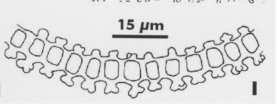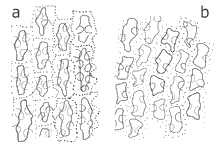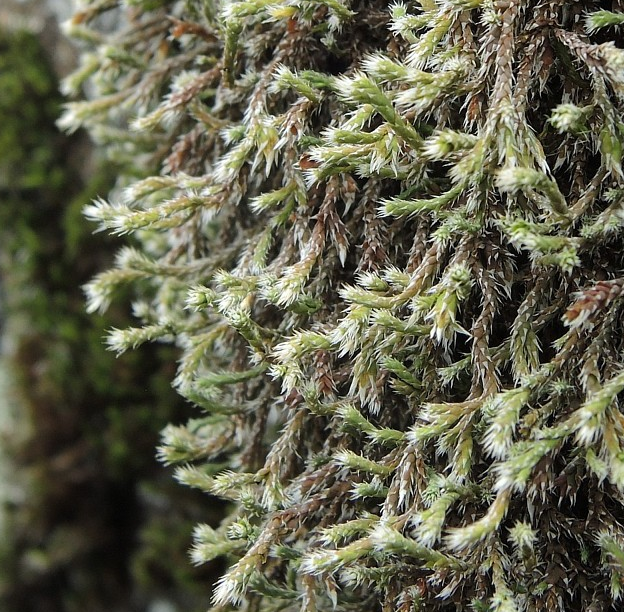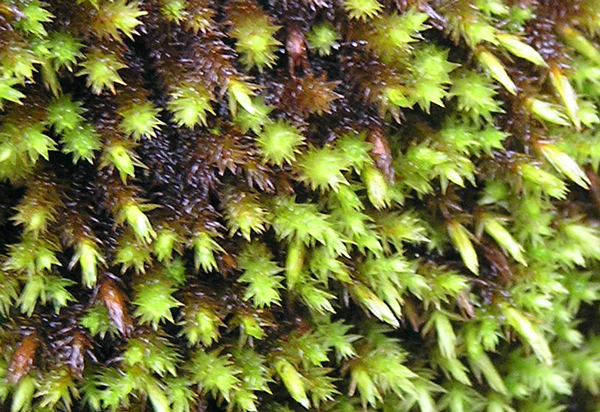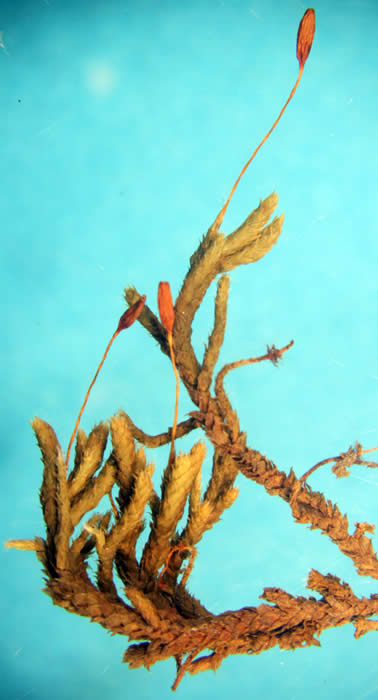HEDWIGIACEAE
KEY TO THE GENERA
Contents of this website
|
||
| KEY TO THE FOUR GENERA OF HEDWIGIACEAE |
1. Medial and upper leaf cells with 1-4 papillae per cell, papillae tall, centered over lumen ....... 2 (Hedwigia and Pseudobraunia)
|
Cross section of leaf showing papillae centered over cell lumen (From Biasuso, 2007) |
|
| 1. Medial and upper leaf cells with 1-6 papillae per cell, papillae low, marginal arching over lumen ....... 3 (Braunia and Hedwigidium) |
Upper leaf cells with marginal papillae arching over cell lumen (From De Luna & Gómez-Velasco, 2008) |
|
2. Seta (0.5) 0.8–1.0 (1.2) mm, capsules immersed, turbinate-urceolate, mouth wide; operculum low, planoconvex, rostrum small mammillate; leaf acumen hyaline-white; perichaetial leaf margins ciliate ......... Hedwigia
2. Seta (4) 6–7 (10) mm, capsules exserted, turbinate, mouth wide; operculum high, conic, short rostrate; perichaetial leaf margins entire .......Pseudobraunia |
Hedwigia detonsa, California (US). Photo by M. Lüth |
|
3. Capsules immersed, turbinate-urceolate, subglobose, mouth wide; operculum low, planoconvex, rostrum small mammillate; perichaetial leaf margins entire, undulate; seta (0.8) 1.0–3.0 (4.0) mm ......... .......Hedwigidium
|
Hedwigidium imberbe, Veracruz (Mex). |
|
3. Capsules exserted, cylindric, ellipsoid, ovate, turbinate, mouth wide or narrow; operculum conic, long rostrate; perichaetial leaf margins entire, not undulate; seta (4) 7–12 (17) mm ............. Braunia |
Braunia plicata, Bolivia. |
|
FROM THE ONLINE VERSION OF CENTRAL AMERICAN MOSSES
Hedwigia Discussion: Hedwigia has often been considered a monospecific genus (see Hedenäs 1994 and Buck & Norris 1996), but presently it contains at least five taxa (H. ciliata (Hedw.) P. Beauv., H. ciliata var. leucophaea Bruch & Schimp. in B.S.G., H. detonsa (M. Howe) W. R. Buck & D. H. Norris, H. nivalis (Müll. Hal.) Mitt., and H. stellata Hedenäs). The genus lacks a stem central strand, paraphyllia, leaf costa, and peristome. Its primary, creeping stems are so poorly developed they are often difficult to demonstrate, and its secondary stems and branches rarely produce stolons. Hedwigia characteristically has broadly ovate, acuminate leaves that end in broad, hyaline acumina, densely papillose leaf cells, immersed, cupulate capsules, and cryptoporic stomata. Although H. detonsa has entire perichaetial leaves, all other species of Hedwigia have long-ciliate perichaetial leaves. Hedwigidium and Hedwigia have immersed capsules, and their gametophytes are very similar.
Braunia Discussion:
|

